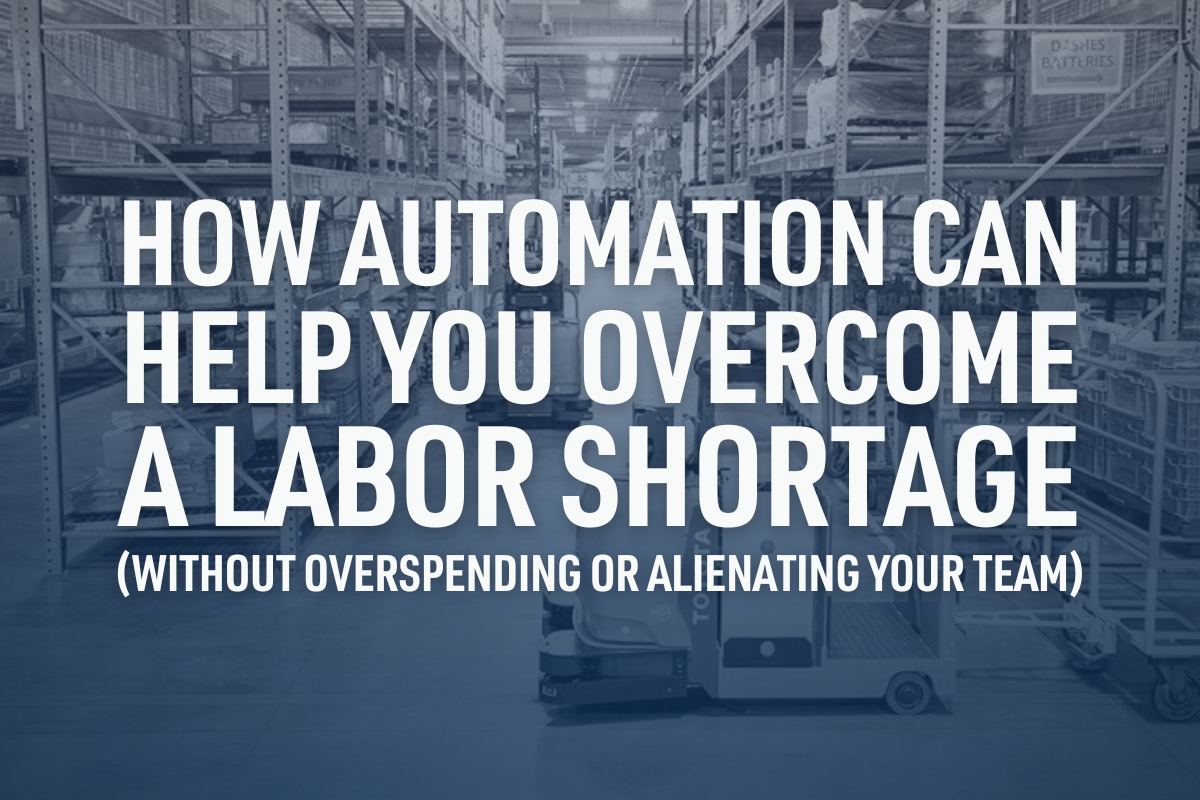4 min read
How Automation Can Help You Overcome a Labor Shortage
![]() Boone Faulkner
Nov 8, 2024 6:02:02 AM
Boone Faulkner
Nov 8, 2024 6:02:02 AM

Hiring and retaining qualified workers is an ongoing challenge for material handling and manufacturing companies. Unfortunately, experts predict the problem will get worse in the years to come.
According to the Bureau of Labor Statistics (BLS), the U.S. manufacturing industry needs more than 188,000 new workers per year to support growth and replace workers who will retire or change jobs. But fewer than 4% of Gen Z workers are interested in a manufacturing job (according to Supply Chain Quarterly).
The warehouse industry also faces a labor problem. Annual turnover reached 49% in 2022 and continues to hover near that all-time high.
As a result, automation adoption is ramping up in both industries. Gartner predicts that, due to a staffing shortage, there will be more smart robots than frontline workers in manufacturing, retail and logistics by 2028. Whether you believe their prediction or not, there’s no doubt the race to automate is on.
In this article, we’ll share our favorite automation solutions to help operations bridge the labor gap — without overspending or alienating loyal team members. We’ll also share strategies for successful implementation and bust two common myths about automation.
There are two big misconceptions that prevent companies from investing in automation. We have an entire eBook that covers all the major myths and misconceptions about automation, but in this article, we’re only going to talk about the top two.
The Biggest Automation Myths and Misconceptions
- Automation is too expensive
- Automating means letting go of valuable team members
Myth #1: Automation is Too Expensive
It’s true some automation solutions come with a big price tag and, unfortunately, there are vendors out there who think bigger is better.
That’s why it’s important to partner with an automation provider who will take the time to learn about your operation and help you choose a solution that’s easy to implement and will deliver fast ROI.
For example, many warehouses can reduce labor costs by 20-50% by using automated guided vehicles (AGVs) to move items around their facility. Basitan’s ML2 AGV can handle up to 441 lbs. and uses LIDAR to avoid people and objects in its path.
You can use the ML2 or other AGVs for:
- Lineside Deliveries
- Pick and Place at P&D Stands
- Assembly Line Conveyance
- Custom Applications
No costly infrastructure is required. You can start with one or two units and add more down the road.
While the machine handles the grunt work, your associates can focus on more complex and interesting tasks. Which takes us to myth number two:
Myth #2: Adding Automation Means Losing Loyal Team Members
This myth has legitimate historical roots. Robots have replaced workers in manufacturing plants. But, as mentioned above, there aren’t enough workers to fill all the manufacturing jobs available.
The truth is: automation replaces tasks, not people. More importantly, it can do things that are boring or likely to cause injury, such as floor loading a trailer. Again, this frees up your team to handle tasks only a human can do.
Automated mobile robots (AMRs, also known as cobots), can help companies respond to seasonal fluctuations. Instead of hiring temporary workers, training them and then letting them go, you can keep the same team year-round and have your cobots work overtime.
How to Add Automation Without a Major Disruption
Here’s the process we use to help clients pinpoint the best solution(s) and implement them with minimal disruption.
1. Ask Workers for InputGathering input from line-level workers and shift supervisors is one of the biggest keys to success.
According to research reported by Supply Chain Executive, companies that sought feedback — especially negative feedback — from their team increased the odds of successful technology transformation by 62%. The study, which included more than 306 companies, also found, “a get with the program mindset decreased the odds of success by 47%.”
Your team can help you identify areas where automation will be the most beneficial, whether that's reducing errors, preventing injuries or minimizing frustration (maybe all three).
There’s a direct relationship between monotonous tasks and worker attrition. By handing off boring tasks to machines, you may also improve worker retention.

We create a custom transition plan for each client, but in general, you’ll want to:
- Hold a series of meetings with associates and stakeholders
- Be open and honest about what the new technology can and can’t do
- Reassure workers they will not lose their jobs
- Describe the new roles and opportunities automation will create
- Inform vendors and other partners (if needed)
- Post a schedule of when the changes will take place
Behind the scenes, we’ll work with your leadership and operations team to minimize production disruptions and shipping delays.
3. Offer Hands-On Training
Most of the solutions we offer are very easy to use and you may be tempted to just do a few demos or have everyone watch a video. But training is about more than showing people how the new equipment works. By giving associates time to get acquainted with new technology you can:
- Turn objections into enthusiasm
- Uncover additional uses for the equipment you may not have thought of
- Alleviate concerns
Be sure to demonstrate safety features and explain how to troubleshoot the new equipment. According to a study conducted by the Harvard Business Review, workers’ #2 and #3 concerns about automation (after job loss) are:
- Inadequate training (35%)
- Malfunctions causing downtime or errors (35%)
Training on new technology can also help workers feel more fulfilled. According to a survey by The American Staffing Association, 80% of employed adults say professional development and training is important to them, but only 39% say their current employer is helping them improve their current skills or gain new skills to do their job better.
If you partner with us, we can take care of the training for you. If you prefer to take the lead, great. We'll provide whatever support you need.
Future-Proof Your Business and Improve Worker Satisfaction
Automation helps workers do their job faster while reducing safety hazards and tedious tasks such as labeling, floor loading a trailer or searching for the next pick location.
The Lilly Company can help you find the right automation solution for your needs and budget. Our team is committed to being a supportive partner on your automation journey from your first consultation to the final product…and beyond. We offer:
- Automated Guided Vehicles (AGVs)
- Automated Storage & Retrieval Systems (AS/RS)
- Sortation, Goods-to-Person, Robotic
- Comprehensive Support
- and so much more!
We can also ensure the solution you choose works with your WMS and other existing systems. Contact an expert at The Lilly Company online or by phone 844-LILLYCO (1-844-545-5926) with any questions you have, or come say hello at one of our 13 locations across the Mid-South.
Arkansas - Jonesboro
Alabama - Birmingham, Dothan, Irondale, Madison, Mobile, and Montgomery
Mississippi - Belden, Tupelo and Richland
Tennessee - Jackson, Kingsport, Knoxville, and Memphis
Further Reading
AGVs 101: Your Guide To Autonomous Warehouse Vehicles
Product Review: Bastian Solutions ML
Answers to Frequently Asked Questions about AGVs
Warehouse Automation ROI Calculator
Posts by Tag
- Forklift (61)
- Forklift Service (19)
- Electric Forklifts (16)
- Forklift Safety (14)
- Forklift Attachments (12)
- Toyota Forklifts (12)
- Warehouse Planning (10)
- Parts (9)
- Warehouse Automation (8)
- Clark Forklifts (7)
- Loading Docks (7)
- Material Handling Education (7)
- Pallet Racking (7)
- Customer Solutions (6)
- Forklift Batteries (6)
- Forklift Rental (6)
- Purchasing Options (6)
- Aerial Equipment (5)
- Heavy Equipment (5)
- Forklift Accessories (4)
- Forklift Fleet Management (4)
- Forklift Tires (4)
- Forklift Training (4)
- Products (4)
- Utility Vehicles (4)
- Yard Spotter Trucks (4)
- Linde (3)
- Pallet Jacks (3)
- Specialty Forklifts (3)
- Used Equipment (3)
- IC Forklifts (2)
- Manitou (2)
- Warehouse Doors (2)
- COMBiLift (1)
- Custom Shop (1)
- Forklift Brakes (1)
- Forklift Warranty (1)
- Gehl (1)
- Komatsu (1)
- Product Review (1)
- Recruitment (1)












